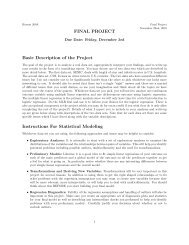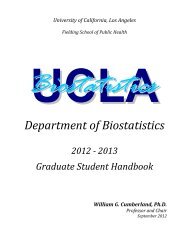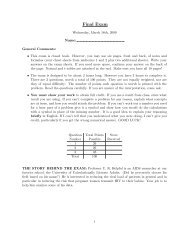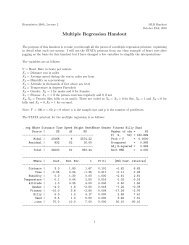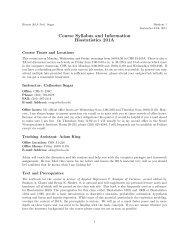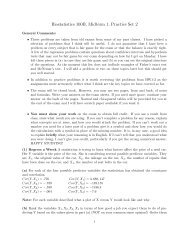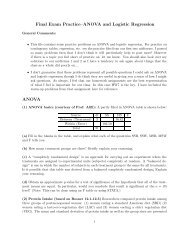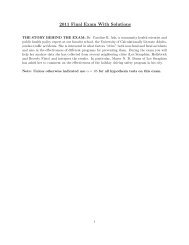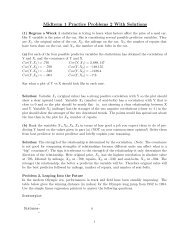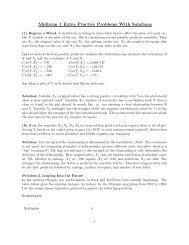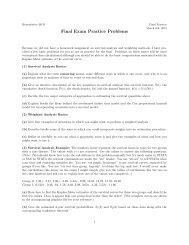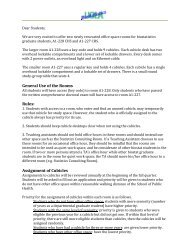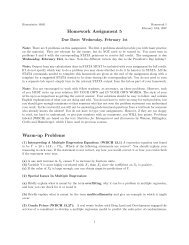Course Syllabus and Information Biostatistics 100B - UCLA ...
Course Syllabus and Information Biostatistics 100B - UCLA ...
Course Syllabus and Information Biostatistics 100B - UCLA ...
- No tags were found...
You also want an ePaper? Increase the reach of your titles
YUMPU automatically turns print PDFs into web optimized ePapers that Google loves.
Biostat <strong>100B</strong>, Prof. Sugar H<strong>and</strong>out 1January 4th, 2010<strong>Course</strong> <strong>Syllabus</strong> <strong>and</strong> <strong>Information</strong><strong>Biostatistics</strong> <strong>100B</strong>This course meets Mondays <strong>and</strong> Wednesdays from 12:00-1:50 p.m. in the Center for Health Sciences (CHS)33-105A. There is also a TA-led discussion section each week on Friday from 12:00-1:50 in 33-105A. Inaddition there are 6 lab sections which meet in CHS A1-241 Tuesdays at 1:00 <strong>and</strong> 2:00, Wednesdays at 2:00,Thursdays at 1:00 <strong>and</strong> 2:00 <strong>and</strong> Fridays at 2:00. If there is a problem with your assigned lab session, contactme as soon as possible. In general the TAs are willing for you to attend multiple labs provided there issufficient space. However, please attend your assigned lab initially so we can get a reasonable headcount.The last day to add or drop the class without a fee is January 15th.Instructor: Catherine SugarOffice: CHS 51-236CPhone: (310) 794-1078FAX: (310) 267-2113E-mail Address: csugar@ucla.eduOffice hours: My official office hours are Monday from 9:00-11:00. However, I am always happy to answerquestions via e-mail or to meet with you at times outside of office hours, especially before <strong>and</strong> after lectures.Because of the size of the class <strong>and</strong> my other obligations it would be helpful if you would call or e-mail aheadto make sure I am free. On Thursdays I will usually be in my secondary office in the Semel NeuropsychiatricInstitute, C8-699, phone (310) 825-6584. I will frequently not be available on Fridays except via e-mail.Teaching Assistants:There are three TAs for this class:Name e-mail Office Hours Office Hour LocationAndrew Glass aglassbrooklyn@aol.com Fri 11:00 am CHS A1-279Wendy Shih wendyshi@ucla.edu TBD CHS A1-279Zilu (Kacy) Zhang zhangzilu83@ucla.edu TBD CHS A1-279They will teach the discussion <strong>and</strong> lab sessions <strong>and</strong> help you with the computer package <strong>and</strong> homeworkassignments. You should feel free to attend any of the office hours, not only the ones held by your labinstructor. The TAs are also happy for you to send them questions via e-mail.Text <strong>and</strong> PrerequisitesThe textbook for the course is Fundamentals of <strong>Biostatistics</strong>, sixth edition by Bernard Rosner. It is optional<strong>and</strong> will supplement my personal lecture notes which will be posted on the class web site. The prerequisitefor this class, <strong>Biostatistics</strong> 100A, covers chapters 1-9 of Rosner, providing a basic introduction to descriptivestatistics, probability, discrete <strong>and</strong> continuous distributions, sampling, estimation, <strong>and</strong> hypothesis testing.There will be a brief review of some of these topics at appropriate points in the course. However, theprerequisite is serious. You need to know <strong>and</strong> be able to use these concepts in order to be successful in<strong>Biostatistics</strong> <strong>100B</strong>. If you are unsure whether you have the necessary background for the course please comesee me as soon as possible.1
<strong>Course</strong> Objectives<strong>Biostatistics</strong> <strong>100B</strong> focuses on modeling relationships between two or more variables. Major topics includecontingency table analysis, simple <strong>and</strong> multiple linear regression, Analysis of Variance (ANOVA) <strong>and</strong> logisticregression. The emphasis will be on learning how to summarize, analyze, <strong>and</strong> interpret real-world data ina practical manner. I will try to include as many examples as possible from medical <strong>and</strong> healthcare studies<strong>and</strong> current events. A detailed outline of the lecture topics is provided in the accompanying h<strong>and</strong>out.ComputingBecause the focus of this class is data analysis <strong>and</strong> statistical modeling, the homework will make consideribleuse of the statistical computing package STATA, to which you were introduced in <strong>Biostatistics</strong> 100A. Youwill be taught the necessary STATA comm<strong>and</strong>s in your lab section. STATA is available on the computers inTechnology <strong>and</strong> Learning Center (TLC) lab in the Biomed Library <strong>and</strong> the CLiCC lab, or you can purchase acopy for use on your own computer. For additional campus locations <strong>and</strong> other STATA resources see the linkson the class web page. There is also a useful set of STATA tutorials at http://www.ats.ucla.edu/stat/stata.H<strong>and</strong>outs <strong>and</strong> the Class Web SiteOur class web site is http://www.biostat.ucla.edu/course/100b/winter10. I will post all course materialsincluding the assignments, solutions, lecture notes, practice exams, class notices, etc. on this site, somake sure you check it regularly. Some files on the web site may be password protected. If I do need toprotect a file I will send out the password via the class e-mail list.Homework <strong>and</strong> Mini Data Analysis ProjectsI consider homework to be the single most important component of this class. It is extremely hard to learnstatistics, or enjoy it, without working through a large number of examples. Assignments will be made <strong>and</strong>turned in on a roughly weekly basis. They will consist of a combination of mathematical problems <strong>and</strong> minidata analysis projects. The write-up is as important as getting the “right” answer. It is critical tolearn to present the results of a statistical analysis in a clear <strong>and</strong> meaningful way. Your homework shouldalways include English explanations of what you are doing, why you are doing it, <strong>and</strong> what the analysisallows you to conclude. If you do not do so, you WILL lose points! An attempt will be made to chooseproblems <strong>and</strong> examples from various areas of public health, medicine <strong>and</strong> current events to make the classmore interesting <strong>and</strong> relevant.Generally, I will give out homework assignments on Mondays <strong>and</strong> they will be due in class the followingMonday though I reserve the right to adjust the timing as necessary. In case people have a few last questionsafter working on the homework over the weekend, I will allow assignments to be turned in to my office byTuesday at noon with no penalty. In weeks in which Monday is a holiday the final time to turn in homeworkwill be Wednesday in class. Other than these grace periods, no late homework will be accepted exceptin extraordinary circumstances <strong>and</strong> with my prior approval. Please check the homework assignment sheetcarefully for the due date <strong>and</strong> grace period information–it is your responsibility to get it in on time! Youmay drop your lowest homework score. Solutions to warm-up problems will be posted on the web whenthe assignment is h<strong>and</strong>ed our <strong>and</strong> solutions to the turn-in problems will be added after the assignments areh<strong>and</strong>ed in. Graded assignments will be returned in class <strong>and</strong>/or your lab session as soon as possible afterthe due date–in most cases in about a week. It is your responsibility to check that your homework has beencorrectly graded. Errors or complaints should be reported directly to me. Changes in scores will not bemade more than two weeks after an assignment or exam has been returned. Unclaimed assignments will bekept in a box in my office up until grades have been submitted at the end of the quarter <strong>and</strong> then discarded.2
Academic IntegrityAcademic integrity is an important part of university life, <strong>and</strong> will be taken seriously in this class. Youmay work on the homework <strong>and</strong> data analysis projects with other students. In fact, interaction with yourclassmates is strongly encouraged. However, each student must write up each assignment on theirown <strong>and</strong> in their own words. There is to be no collaboration during examinations.Students with DisabilitiesAny student requesting academic accommodations based on a disability should register with the <strong>UCLA</strong>Office for Students with Disabilities. A letter of verification for approved accommodations can be obtainedfrom the OSD. Please be sure the letter is delivered to me as early in the quarter as possible so that Ican make any necessary arrangements. The OSD is located in A255 Murphy Hall <strong>and</strong> their website ishttp://www.osd.ucla.edu.ExamsThere will be two midterms <strong>and</strong> a final exam in this course:Midterm 1: Friday, January 29th, IN DISCUSSION, 12:00-1:50 pm. (110 minutes)Midterm 2: Friday, February 26th, IN DISCUSSION, 12:00-1:50 pm. (110 minutes)Final Exam: Monday, March 15th, 3:00-6:00 pm.(180 minutes), location TBAAll exams are closed book, closed notes. However, you may bring 2 sheets of paper (8.5 by 11) with formulas<strong>and</strong> notes on both sides to the midterms, <strong>and</strong> your midterm notes plus two additional sheets to the final.You should also bring a calculator <strong>and</strong> writing instrument. Any additional materials, including numericaltables, will be provided unless specified in class prior to the exam. There will be no late, early, or repeatexams except where required by university policy.GradesGrades will be based on:15% Homework <strong>and</strong> mini data analysis projects. (There will be roughly seven graded assignments, weightedequally unless specifically noted otherwise, <strong>and</strong> you may drop your lowest score.)25% Midterm 125% Midterm 235% Final ExamHowever, if it is to your benefit, you may drop the lower of the your two midterm scores to 10% <strong>and</strong> increasethe weight of the final exam to 50%. You will automatically be given the optimal score. There are nodecisions to make in advance. What this means is, do your homework–it can not be dropped; the midtermsallow you to improve on your final score. It is also worthwhile to participate in class. Although it is notpart of the numerical grading formula, I do take effort <strong>and</strong> participation into account when determining thegrade cutoffs.3



